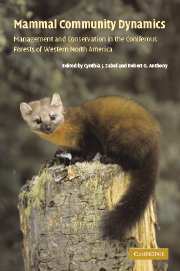 Mammal Community Dynamics
Mammal Community Dynamics Book contents
- Frontmatter
- Contents
- List of contributors
- Foreword
- Acknowledgments
- Part I Management and conservation issues for various taxa
- 1 Introduction and historical perspective
- 2 Forests and woodlands of western North America
- 3 Faunal composition and distribution of mammals in western coniferous forests
- 4 Habitat ecology and conservation of bats in western coniferous forests
- 5 Ecological relationships of terrestrial small mammals in western coniferous forests
- 6 Ecology and conservation of arboreal rodents of western coniferous forests
- 7 Small and mid-sized carnivores
- 8 Ecology, conservation, and restoration of large carnivores in western North America
- 9 Ungulates in western coniferous forests: habitat relationships, population dynamics, and ecosystem processes
- Part II Community and ecosystem relations
- Part III Conservation issues and strategies
- Index
- References
3 - Faunal composition and distribution of mammals in western coniferous forests
Published online by Cambridge University Press: 15 December 2009
- Frontmatter
- Contents
- List of contributors
- Foreword
- Acknowledgments
- Part I Management and conservation issues for various taxa
- 1 Introduction and historical perspective
- 2 Forests and woodlands of western North America
- 3 Faunal composition and distribution of mammals in western coniferous forests
- 4 Habitat ecology and conservation of bats in western coniferous forests
- 5 Ecological relationships of terrestrial small mammals in western coniferous forests
- 6 Ecology and conservation of arboreal rodents of western coniferous forests
- 7 Small and mid-sized carnivores
- 8 Ecology, conservation, and restoration of large carnivores in western North America
- 9 Ungulates in western coniferous forests: habitat relationships, population dynamics, and ecosystem processes
- Part II Community and ecosystem relations
- Part III Conservation issues and strategies
- Index
- References
Summary
Mammals are prominent features of the landscape in coniferous forests of western North America. Large herbivores such as deer, elk, moose, and caribou are particularly noticeable. Smaller, though no less conspicuous, mammals include diurnal ground squirrels, marmots, pikas, and numerous species of chipmunks, and nocturnal bats. Overall, the mammalian faunas of western coniferous forests are rich and varied. Knowledge of their taxonomic makeup and biogeography provides a foundation for understanding current patterns of distribution, habitat use, and management. An examination of the distribution and diversity patterns of coniferous-forest species, together with an assessment of the factors influencing these patterns, forms the basis for this review.
Faunal composition
Nearly half (194) of approximately 400 species of mammals occurring in North America north of Mexico occupy western coniferous forests and associated meadow, brush, or riparian habitats (Table 3.1, Appendix). Eight orders and 27 families of mammals are represented. Per unit area, western North America has a much higher species richness than other temperate or boreal areas of the continent. This difference is readily discernible when comparing western and eastern coniferous forests (Hallett et al. 2003). Chipmunks (Tamias spp.) constitute a striking example: 21 species of chipmunks occupy western coniferous forests; there is only one (Tamias striatus) in eastern forests. Similar, though less dramatic examples, occur among shrews (Sorex spp.), bats (Myotis spp.), ground squirrels (Spermophilus spp., Marmota spp.), and other rodents (e.g., Peromyscus spp.).
The list of species (Table 3.1, Appendix) is somewhat loosely drawn.
- Type
- Chapter
- Information
- Mammal Community DynamicsManagement and Conservation in the Coniferous Forests of Western North America, pp. 41 - 80Publisher: Cambridge University PressPrint publication year: 2003
References
- 7
- Cited by


